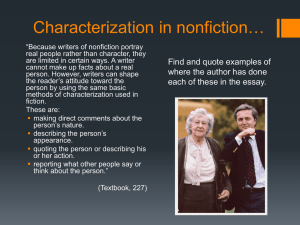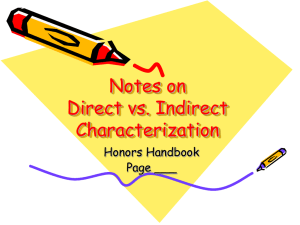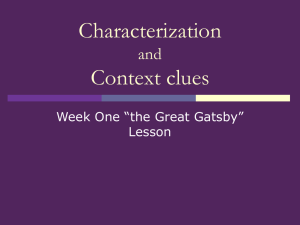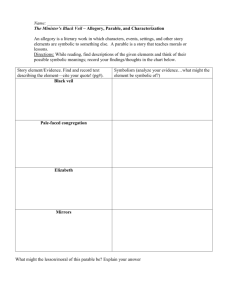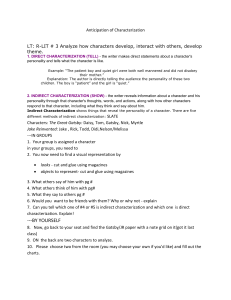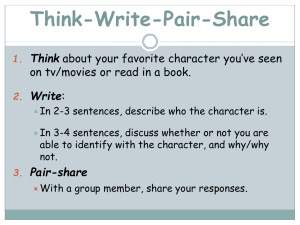Elements of Literature: Character
advertisement
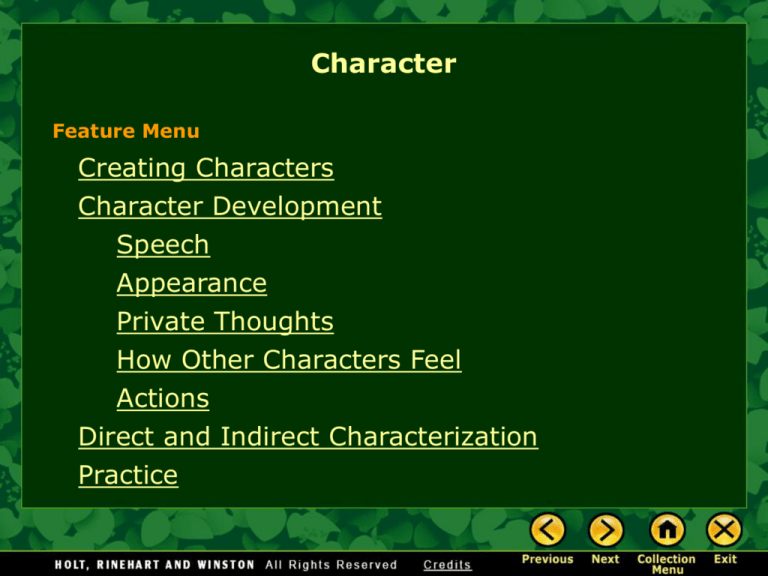
Character Feature Menu Creating Characters Character Development Speech Appearance Private Thoughts How Other Characters Feel Actions Direct and Indirect Characterization Practice Creating Characters Creating characters—telling what human beings are like—is the whole point of writing stories. [End of Section] Character Development Writers build characters by revealing speech appearance others’ reactions private thoughts actions Character Development Quick Check “Keep still, you little devil, or I’ll cut your throat!” A fearful man, all in coarse grey, with a great iron on his leg. A man with no hat, and with broken shoes, and with an old rag tied round his head. A man who had been soaked in water, and smothered in mud, and lamed by stones, and cut by flints . . . ; who limped, and shivered, and glared and growled; and whose teeth chattered in his head as he seized me by the chin. from Great Expectations by Charles Dickens Which methods of character development are being used? What do you think of the man based on this excerpt? [End of Section] Speech First-person narrators reveal their personal traits as they • tell their own stories (using pronouns like I, me, and we) • tell us what they think and feel Be aware that some first-person narrators mislead or lie to the audience. Dramatic Monologue Soliloquy Speech Dialogue can reveal a lot about characters and their relationships with each other. Pay attention to • what characters say and don’t say • how characters respond to each other [End of Section] Appearance Pay attention to language the writer uses to describe the characters’ looks, clothes, and demeanor. The cold within him froze his old features, nipped his pointed nose, shriveled his cheek, stiffened his gait; made his eyes red, his thin lips blue. . . . from A Christmas Carol by Charles Dickens • Does the description give you a positive or negative impression of the character? • Which words contribute to this impression? [End of Section] Private Thoughts Writers can take us into the characters’ minds to reveal their thoughts and feelings. As you read, note whether the characters’ thoughts and feelings match their speech and actions. [End of Section] How Other Characters Feel Watch how other characters in the story react to the character. Note • how the others feel about the character • what the others say about the character [End of Section] Actions What characters do and how they treat each other often reveal the most about them. Observe characters’ actions to determine • what their personality is like • what motivates them • how they deal with conflict [End of Section] Direct and Indirect Characterization Direct Characterization—Writers tell us directly what characters are like or what their motives are. Oh, but he was a tightfisted hand at the grindstone, Scrooge! a squeezing, wrenching, grasping, scraping, clutching, covetous old sinner! from A Christmas Carol by Charles Dickens Indirect Characterization—Writers show us characters (through speech, appearance, private thoughts, other characters’ reactions, and actions) but allow us to decide what characters are like. Direct and Indirect Characterization Quick Check My sister, Mrs. Joe, with black hair and eyes, had such a prevailing redness of skin that I sometimes used to wonder whether it was possible she washed herself with a nutmeg-grater instead of soap. She was tall and bony, and almost always wore a coarse apron, fastened over her figure behind with two loops, and having a square impregnable bib in front, that was stuck full of pins and needles. Is this an example of direct or indirect characterization? What kind of person do you think this character is? from Great Expectations by Charles Dickens [End of Section] Practice Who is the most unforgettable character you’ve ever met in a story? Write a few sentences about why you find the character so memorable. Before you begin, jot down your ideas on a chart like this one. Most memorable character Most outstanding character Character’s appearance Important statements Important thoughts Important actions Reactions of other characters [End of Section] The End
